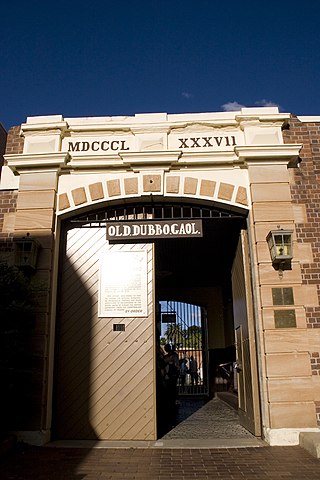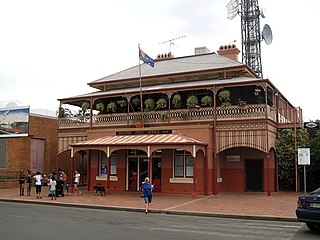
The Wentworth Gaol is a heritage-listed former gaol and school building and now museum and old wares shop located at 112 Beverley Street, Wentworth, in the Wentworth Shire, New South Wales, Australia. It was designed by James Barnet and built from 1879 to 1881 by Whitcombe Brothers, Hay. It is also known as the Old Wentworth Gaol. The property is owned by Department of Primary Industries - Western Lands Commissioner, an agency of the Government of New South Wales. The property was added to the New South Wales State Heritage Register on 21 October 2016.

The Chief Secretary's Building is a heritage-listed state government administrative building of the Victorian Free Classical architectural style located at 121 Macquarie Street, 65 Bridge Street, and at 44–50 Phillip Street in the Sydney central business district of New South Wales, Australia. The ornate five-storey public building was designed by Colonial Architect James Barnet and built in two stages, the first stages being levels one to four completed between 1873 and 1881, with Walter Liberty Vernon completing the second stage between 1894 and 1896 when the mansard at level five and the dome were added.

The Old Dubbo Gaol is a heritage-listed former gaol and now museum and tourist attraction at 90 Macquarie Street, Dubbo in the Dubbo Regional Council local government area of New South Wales, Australia. The gaol was designed by the NSW Colonial Architect's Office and was built from 1847 to 1945 by James Atkinson Jnr (1862–63) and William Bonython Moffatt. The gaol is also known as the Dubbo Jail and the Dubbo Gaol. The building was added to the New South Wales State Heritage Register on 26 March 2004. The building was the second gaol in Dubbo, replacing lockups built in 1847 and 1862.

The Old Cleveland Police Station is a heritage-listed police station at 1 Passage Street, Cleveland, City of Redland, Queensland, Australia. It was built from 1934 to 1935. It was added to the Queensland Heritage Register on 26 March 1999.

The Justice and Police Museum is a heritage-listed former water police station, offices and courthouse and now justice and police museum located at 4-8 Phillip Street on the corner of Albert Street, in the Sydney central business district in the City of Sydney local government area of New South Wales, Australia. It was designed by Edmund Blacket, Alexander Dawson and James Barnet and built from 1854 to 1886. It is also known as Police Station & Law Courts (former) and Traffic Court. The property is owned by the Department of Justice, a department of the Government of New South Wales. It was added to the New South Wales State Heritage Register on 2 April 1999.

The Central Local Court House or Police Law Courts or Central Police Court is a heritage-listed building located at 98 Liverpool Street, in the central business district of Sydney, New South Wales in Australia. Constructed in the Federation Free Classical style based on original designs by Colonial Architect, James Barnet, the building structure was completed in 1892 under the supervision of Barnet's successor, Government Architect, Walter Liberty Vernon. It is also known as Sydney Central Local Court House, Police Law Courts and Central Police Court. The property is owned by the Department of Justice, a department of the Government of New South Wales. It was added to the New South Wales State Heritage Register on 2 April 1999. The court house is located in a precinct that includes the Downing Centre, and buildings housing the Family Court of Australia and the Federal Circuit Court in Sydney. Adjacent to the court house is Brickfield Place, a brick paved courtyard with seating and planter boxes, constructed in 1892, assessed as a good example of urban design for public open space.

Bathurst Courthouse is a heritage-listed courthouse at Russell Street, Bathurst, in the Central West region of New South Wales, Australia. Constructed in the Federation Free Classical style based on original designs by Colonial Architect, James Barnet, the building structure was completed in 1880 under the supervision of Barnet's successor, Government Architect, Walter Liberty Vernon. The property is owned by Attorney General's Department. It was added to the New South Wales State Heritage Register on 2 April 1999.

Goulburn Court House is a heritage-listed courthouse at 4 Montague Street, Goulburn, Goulburn Mulwaree Council, New South Wales, Australia. It was designed in the Federation Free Classical style based on original designs by Colonial Architect, James Barnet and his assistant Edward Rumsey. It was built from 1885 to 1887 by David Jones. The property is owned by the New South Wales Department of Justice. It was added to the New South Wales State Heritage Register on 2 April 1999.

Albury Post Office is a heritage-listed post office at 570 Dean Street, Albury, in the Riverina region of New South Wales, Australia. It was designed by NSW Colonial Architects Office under James Barnet and built in 1880. The property is owned by Australia Post. It was added to the New South Wales State Heritage Register on 17 December 1999. On 8 November 2011 the building was listed on the Commonwealth Heritage List; and is listed on the Register of the National Estate since 21 March 1978.
The Old Police Station and Courthouse is a heritage-listed former police station and courthouse located at 74 Binnia Street, Coolah, in the Warrumbungle Shire, New South Wales, Australia. It was designed by the Colonial Architect of New South Wales, James Barnet, and built from 1878 to 1880 by Henry S. Winter. It was added to the New South Wales State Heritage Register on 2 April 1999.

Bourke Post Office is a heritage-listed post office at 47 Oxley Street, Bourke, in the Orana region of New South Wales, Australia. It was designed by the Colonial Architect's Office under James Barnet and built in 1880 by E. Heseler. It is also known as Bourke Post and Telegraph Office. The property is owned by the Keane Family Trust. It was added to the New South Wales State Heritage Register on 23 June 2000.

The Narrabri Gaol and Residence is a heritage-listed former gaol and now museum at Bowen Street, Narrabri, Narrabri Shire, New South Wales, Australia. The building was designed by James Barnet and built from 1880 to 1881 by J. Conlon. The property is owned by Narrabri Shire Council and was added to the New South Wales State Heritage Register on 2 April 1999.

The Tenterfield Post Office is a heritage-listed post office located at 225 Rouse Street, Tenterfield, Tenterfield Shire, New South Wales, Australia. It was designed by NSW Colonial Architect's Office under James Barnet and built from 1881 to by T. & J. McGuaran, later T. A. Lewis. It is also known as the Tenterfield Post Office and Quarters. The property is owned by Australia Post. It was added to the New South Wales State Heritage Register on 17 December 1999.
Berry Courthouse is a heritage-listed former courthouse and now function venue at 58 Victoria Street, Berry, in the South Coast region of New South Wales, Australia. It was designed by James Barnet and built from 1890 to 1891 by Antonio and Peter Ettinghausen. The property is owned by Shoalhaven City Council. It was added to the New South Wales State Heritage Register on 15 July 2005.

Old Port Macquarie Courthouse is a heritage-listed former courthouse and now justice museum at Clarence Street (cnr), Port Macquarie, Port Macquarie-Hastings Council, New South Wales, Australia. It was designed by James Barnet and built in 1869 by Butler and Bourne. It was added to the New South Wales State Heritage Register on 2 April 1999.

Maitland Post Office is a heritage-listed post office at 381 High Street, Maitland, City of Maitland, New South Wales, Australia. It was designed by the NSW Colonial Architect's Office under James Barnet and built in 1881. The property is owned by Australia Post. It was added to the New South Wales State Heritage Register on 17 December 1999.

The North Sydney Post Office is a heritage-listed post office located at 92-94 Pacific Highway, North Sydney, North Sydney Council, New South Wales, Australia. It was designed by the Colonial Architect’s Office under the direction of James Barnet, and built from 1885 to 1889 by James Reynolds. The property is owned by Australia Post, an agency of the Australian Government. It was added to the New South Wales State Heritage Register on 22 December 2000.

Richmond Post Office is a heritage-listed former post office at 286 Windsor Street, Richmond, City of Hawkesbury, New South Wales, Australia. It was designed by Colonial Architect James Barnet and built from 1875 to 1888. The original building was built by a Mr. Johnson, with the second-story addition in 1888 added by Samuel Bought. It is also known as Richmond Telegraph and Post Office. It was added to the New South Wales State Heritage Register on 23 June 2000.

The Old Police Station, The Rocks is a heritage-listed former police station and now home to Sergeant Lok, a Modern Asian restaurant and bar, that is located at 127–129 George Street in the inner city Sydney suburb of The Rocks in the City of Sydney local government area of New South Wales, Australia. It was designed by James Barnet and built in 1882 by W. Cains and Sons. The property is owned by Property NSW, an agency of the Government of New South Wales. It was added to the New South Wales State Heritage Register on 10 May 2002.

The Clarence Street Police Station is a heritage-listed former police station and now community service office located at 281 Clarence Street, Sydney, Australia. It was designed by James Barnet as the NSW Government Architect and was built from 1890 to 1928. It was added to the New South Wales State Heritage Register on 2 April 1999.


















